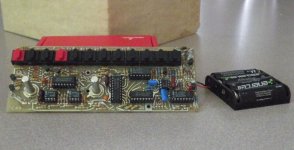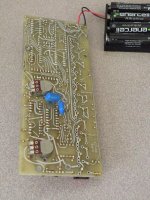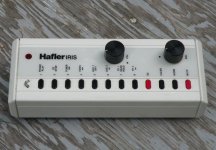I've gotten my Hafler Iris remote control working again, just too well. It uses what I assume is capacitive sensing to start and stop transmitting the positions of the volume and balance pots. When I touch either knob it correctly changes the volume of my preamp to what the remote's knobs are set to. It just doesn't quit transmitting when I let go. Sometimes it stops after 10-30 seconds. Sometimes I have to take out a battery to stop it.
Now some background. It was tending this way a few years ago, especially during the summer. Finally it went on by itself, ran the batteries down and made them leak. I cleaned up the electrolyte and replaced a corroded IR LED. The battery pack wires had corroded and broke while I was handling it. Things got more complicated when I wired the new battery pack backwards and blew a power diode. I've replaced the diode with one that I guess is equivalent. I guess that the IR LED is equivalent too. I have no idea if any other component is damaged. The other IR LED (there are 2) has a little discoloration on the leads inside the package, but it may be working. Could the IR LEDs be part of the capacitive sensing circuit? That's hard to believe.
There's nothing obvious to adjust the capacitive sensitivity. I now see a spot or two of dried electrolyte that I missed. I'll try to clean it up with some distilled water on a flux brush and dry it quickly. Any other suggestions to troubleshoot this problem? Any other forums that might have experience with this kind of circuit? I've asked around about a schematic, but I'm not sure that it would help me and nobody seems to have one.
Now some background. It was tending this way a few years ago, especially during the summer. Finally it went on by itself, ran the batteries down and made them leak. I cleaned up the electrolyte and replaced a corroded IR LED. The battery pack wires had corroded and broke while I was handling it. Things got more complicated when I wired the new battery pack backwards and blew a power diode. I've replaced the diode with one that I guess is equivalent. I guess that the IR LED is equivalent too. I have no idea if any other component is damaged. The other IR LED (there are 2) has a little discoloration on the leads inside the package, but it may be working. Could the IR LEDs be part of the capacitive sensing circuit? That's hard to believe.
There's nothing obvious to adjust the capacitive sensitivity. I now see a spot or two of dried electrolyte that I missed. I'll try to clean it up with some distilled water on a flux brush and dry it quickly. Any other suggestions to troubleshoot this problem? Any other forums that might have experience with this kind of circuit? I've asked around about a schematic, but I'm not sure that it would help me and nobody seems to have one.
It would help to see a picture of the remote as I've never seen one of these.
Are you sure it's not just a "membrane" overlay on the handset. (These were common on many consumer remotes and front panels of equipment) and always gave trouble after a while. Basically two conductive sheets that rely on pressure to make the connection and they often became more conducting than not.
Membrane keypads,
http://www.bing.com/images/search?q...D4C0B687D2FCD88A490661F8C1159CBFD51B&first=36
Are you sure it's not just a "membrane" overlay on the handset. (These were common on many consumer remotes and front panels of equipment) and always gave trouble after a while. Basically two conductive sheets that rely on pressure to make the connection and they often became more conducting than not.
Membrane keypads,
http://www.bing.com/images/search?q...D4C0B687D2FCD88A490661F8C1159CBFD51B&first=36
Last edited:
Wish I could show a picture
Sorry, but I can't find the mechanism for creating an album described in the FAQ, so no photos. I'll just have to tell you that this circuit in no way uses a membrane switch. This has to be a capacitance sensing circuit. The shafts and cases of the volume and balance pots are connected through RC circuits to the inputs of a LM8030N Op-amp transconductance amplifier. I can't figure out any more than that.
Sorry, but I can't find the mechanism for creating an album described in the FAQ, so no photos. I'll just have to tell you that this circuit in no way uses a membrane switch. This has to be a capacitance sensing circuit. The shafts and cases of the volume and balance pots are connected through RC circuits to the inputs of a LM8030N Op-amp transconductance amplifier. I can't figure out any more than that.
Click on "Advanced" if that option is showing and then "Manage Attachments" then go to "Upload File from your Computer" click browse and navigate to where the picture is that you want to post and click "OK." Remember to click "Upload" once you have selected all of the pictures you want to upload. Try to keep pictures in the 800 x 600 range to avoid too large files.
Some photos
Wow. That's not what the FAQ says. Firstly, there's an "Insert Image" icon in the "Reply to Thread" editor. That requires a URL, so I went looking for creating an album. The directions in the FAQ talk about a "Pictures and Albums" link in the CP. Dead end. Anyway....
Wow. That's not what the FAQ says. Firstly, there's an "Insert Image" icon in the "Reply to Thread" editor. That requires a URL, so I went looking for creating an album. The directions in the FAQ talk about a "Pictures and Albums" link in the CP. Dead end. Anyway....
Attachments
Thanks for the pics... now that is one oddball remote for sure. So we have push buttons for certain functions and true analogue pots for the volume and balance.
I don't think there is any capacitive sensing going on as it seems to detect where the pots are (resistance value) and code that in some way.
Do you position the pots first and then press a "send" button or is it working all the time and you just move the pot and the one on the amp follows suit ? Thats an important question because it eliminate a button and the possibilty of a problem in that area.
Without seeing and getting a feel for this I don't know, but would suggest basic handset repair tatics. I used to see hundreds of remotes in the course of the day job and a favourite tatic was to totally wash the PCB with foam cleaner and a brush and then rinse and dry. As long as there are no "open" parts there isn't a problem but I see you have all those switches. To wet them without knowing their construction could cause a problem. You could do everything else though.
You need to pin this down a little... I'm intrigued
I don't think there is any capacitive sensing going on as it seems to detect where the pots are (resistance value) and code that in some way.
Do you position the pots first and then press a "send" button or is it working all the time and you just move the pot and the one on the amp follows suit ? Thats an important question because it eliminate a button and the possibilty of a problem in that area.
Without seeing and getting a feel for this I don't know, but would suggest basic handset repair tatics. I used to see hundreds of remotes in the course of the day job and a favourite tatic was to totally wash the PCB with foam cleaner and a brush and then rinse and dry. As long as there are no "open" parts there isn't a problem but I see you have all those switches. To wet them without knowing their construction could cause a problem. You could do everything else though.
You need to pin this down a little... I'm intrigued
Oops, washing right now
It's not necessary to move the pots to make the remote xmit; just touch the metal knob or the bare shaft or the potentiometer case. Even if I touch any of these with a piece of wire, it xmits. There is definitely a trace from the lock-nut to a cap and then to the op-amp. I am convinced that this is a capacitance sensing circuit.
Thanks for the suggestions. I'm sorry to learn that you don't suggest cleaning the board because of the open switches (& pots). I have already done a careful rinsing of visible corrosion spots with distilled water on a flux brush. I don't think that any got into the open components. Now I'm going over it more aggressively with reagent-grade isopropanol and blowing off the liquid with compressed air. I hope that if any rosin flux gets carried onto contacts I will be able to clean them with Caig Cramolin R-2 spray.
It's not necessary to move the pots to make the remote xmit; just touch the metal knob or the bare shaft or the potentiometer case. Even if I touch any of these with a piece of wire, it xmits. There is definitely a trace from the lock-nut to a cap and then to the op-amp. I am convinced that this is a capacitance sensing circuit.
Thanks for the suggestions. I'm sorry to learn that you don't suggest cleaning the board because of the open switches (& pots). I have already done a careful rinsing of visible corrosion spots with distilled water on a flux brush. I don't think that any got into the open components. Now I'm going over it more aggressively with reagent-grade isopropanol and blowing off the liquid with compressed air. I hope that if any rosin flux gets carried onto contacts I will be able to clean them with Caig Cramolin R-2 spray.
Just being careful with the recommends on washing. I used to wash whole TV 'chassis (and we're talking very high voltage here) with no problems at all as long as they were totally dried afterwards. Just don't want you to run into trouble with a part that may take eons to dry... and any moisture really is a problem when voltage is applied as it causes electrolysis.
I'm really intrigued though as I say.
So is that the way it is meant to work by design, that you just touch the metal knob and it transmits ? If so then capacitive touch sounds likely.
So if you have the unit on say a table and touch the volume pot it transmits, but then continues to do so as your finger is removed when it should have stopped ?
I'm really intrigued though as I say.
So is that the way it is meant to work by design, that you just touch the metal knob and it transmits ? If so then capacitive touch sounds likely.
So if you have the unit on say a table and touch the volume pot it transmits, but then continues to do so as your finger is removed when it should have stopped ?
You got it.
Thanks for the warning about electrolysis. I expect the 100% isopropanol to carry off any moisture and I'm using 50 psi (3.5 bar) air to blow everything away. I'm following the tutorial given by Warren Young in How to Clean Circuit Boards. The board has plenty of time to dry while I fix the battery pack leads which have broken off again due to my handling.
To get a more detailed understanding of how this volume control system works, see the Stereophile article, Hafler Iris preamplifier | Stereophile.com , page 2. There's a relevant anecdote near the end of the article too.
Yes, that's it exactly. It's not being consistent about it either. Today it was working well. That may be because it was out of it's case and without the knobs or maybe because the humidity is low. (The original problem was spontaneous xmitting on very humid days, which eventually caused the batteries to leak.)So if you have the unit on say a table and touch the volume pot it transmits, but then continues to do so as your finger is removed when it should have stopped?
Thanks for the warning about electrolysis. I expect the 100% isopropanol to carry off any moisture and I'm using 50 psi (3.5 bar) air to blow everything away. I'm following the tutorial given by Warren Young in How to Clean Circuit Boards. The board has plenty of time to dry while I fix the battery pack leads which have broken off again due to my handling.
To get a more detailed understanding of how this volume control system works, see the Stereophile article, Hafler Iris preamplifier | Stereophile.com , page 2. There's a relevant anecdote near the end of the article too.
Thanks for the Hafler link, interesting stuff.
I think you will have to see how the cleaning goes. I would carefully remove the IC's too and wash those particularly around the pins (be carefull of static precautions on any relevant devices) and use a soft brush to get under the IC sockets.
You mention high humidity. Is the board laquered and become sticky. If so that could be a problem and may require more aggressive cleaning perhaps with pure ISO.
I think you will have to see how the cleaning goes. I would carefully remove the IC's too and wash those particularly around the pins (be carefull of static precautions on any relevant devices) and use a soft brush to get under the IC sockets.
You mention high humidity. Is the board laquered and become sticky. If so that could be a problem and may require more aggressive cleaning perhaps with pure ISO.
I haven't gone as far as removing the IC's. Maybe I will. This is starting to drive me to distraction. Every evening, as the humidity rises, it starts acting up. Or maybe it's after it has been powered for a few hours. Controlled experiments are difficult to run. Could it be a capacitor getting leaky? It only has some kind of plastic (metalized polyester?) ceramic disc and tantalum.Thanks for the Hafler link, interesting stuff.
I think you will have to see how the cleaning goes. I would carefully remove the IC's too and wash those particularly around the pins (be carefull of static precautions on any relevant devices) and use a soft brush to get under the IC sockets.
You mention high humidity. Is the board laquered and become sticky. If so that could be a problem and may require more aggressive cleaning perhaps with pure ISO.
The small "compressed" ceramic discs are a favourite for leakage. Old tantalums can be a problem to although often its because of the design not observing the working limitations of them. For example the rate of voltage rise time across the cap. That said they do just fail. Small poly caps very unlikely to be leaky.
Has to be worth swapping the caps. You would have to see what the tants are used for. If its as a sample and hold then low leakage is vital and would need like for like replacement. For most other uses I would guess that these days small electrolytics could well meet the needs. No harm in trying them anyway.
The IC's are the least likely suspects but could suffer from any atmospheric film that absorbs moisture... a good wash of the chips would sort that. The sockets could be a problem if you be 100% sure they (and the PCB) are clean underneath.
Has to be worth swapping the caps. You would have to see what the tants are used for. If its as a sample and hold then low leakage is vital and would need like for like replacement. For most other uses I would guess that these days small electrolytics could well meet the needs. No harm in trying them anyway.
The IC's are the least likely suspects but could suffer from any atmospheric film that absorbs moisture... a good wash of the chips would sort that. The sockets could be a problem if you be 100% sure they (and the PCB) are clean underneath.
- Status
- This old topic is closed. If you want to reopen this topic, contact a moderator using the "Report Post" button.
- Home
- Source & Line
- Analog Line Level
- Remote control won't shut up


